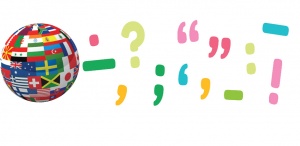Difference between revisions of "Language/Multiple-languages/Grammar/Punctuation-of-many-languages"
| Line 3: | Line 3: | ||
== Marks == | == Marks == | ||
=== Common === | === Most Common === | ||
{| class="wikitable" | {| class="wikitable" | ||
! | ! | ||
! | !Latin, Cyrillic. Korean | ||
!Arabic | |||
!Japanese | !Japanese | ||
!Chinese | !Chinese | ||
| Line 12: | Line 13: | ||
|comma | |comma | ||
|''',''' | |''',''' | ||
|'''،''' | |||
|'''、''' | |'''、''' | ||
|''',''' | |''',''' | ||
|- | |- | ||
|period | |period | ||
|'''.''' | | colspan="2" |'''.''' | ||
| colspan="2" |'''。''' | | colspan="2" |'''。''' | ||
|- | |- | ||
|parentheses | |parentheses | ||
|'''( )''' | | colspan="2" |'''( )''' | ||
| colspan="2" |'''()''' | | colspan="2" |'''()''' | ||
|- | |- | ||
|question mark | |question mark | ||
|'''?''' | |'''?''' | ||
|'''؟''' | |||
| colspan="2" |'''?''' | | colspan="2" |'''?''' | ||
|- | |- | ||
|exclamation mark | |exclamation mark | ||
|'''!''' | | colspan="2" |'''!''' | ||
| colspan="2" |'''!''' | | colspan="2" |'''!''' | ||
|- | |- | ||
|colon | |colon | ||
|''':''' | | colspan="2" |''':''' | ||
| colspan="2" |''':''' | | colspan="2" |''':''' | ||
|- | |- | ||
|semicolon | |semicolon | ||
|''';''' | |''';''' | ||
|'''؛''' | |||
| colspan="2" |''';''' | | colspan="2" |''';''' | ||
|} | |} | ||
| Line 42: | Line 46: | ||
=== Quotation marks === | === Quotation marks === | ||
{| class="wikitable" | {| class="wikitable" | ||
|+Some have alternatives | |||
! | ! | ||
!Primary | !Primary | ||
| Line 219: | Line 224: | ||
|'''„…”''' | |'''„…”''' | ||
|'''»…«''' | |'''»…«''' | ||
| | | | ||
|- | |- | ||
| Line 241: | Line 240: | ||
| | | | ||
|- | |- | ||
| | |Bulgarian | ||
|'''„…“''' | |'''„…“''' | ||
|'''‘…’''' | |'''’…’''' | ||
'''‘…’''' | |||
| | | | ||
|- | |- | ||
| Line 249: | Line 249: | ||
|'''„…“''' | |'''„…“''' | ||
|'''’…‘''' | |'''’…‘''' | ||
| | |||
|- | |||
|Albanian | |||
|'''„…“''' | |||
|'''‘…’''' | |||
| | | | ||
|- | |- | ||
| Line 263: | Line 268: | ||
Japanese | Japanese | ||
|'''「…」<br> | |'''「…」<br>''' | ||
'''﹁<br>︰<br>﹂''' | '''﹁<br>︰<br>﹂''' | ||
|'''『…』<br> | |'''『…』<br>''' | ||
'''﹃<br>︰''' | '''﹃<br>︰''' | ||
Revision as of 20:41, 8 June 2017
Marks
Most Common
| Latin, Cyrillic. Korean | Arabic | Japanese | Chinese | |
|---|---|---|---|---|
| comma | , | ، | 、 | , |
| period | . | 。 | ||
| parentheses | ( ) | () | ||
| question mark | ? | ؟ | ? | |
| exclamation mark | ! | ! | ||
| colon | : | : | ||
| semicolon | ; | ؛ | ; | |
Quotation marks
| Primary | Secondary | Spacing | |
|---|---|---|---|
| English, United Kindom
Scottish Gaelic Welsh |
‘…’ | “…” | English: 1–2 pt
Welsh: 1–2 pt |
| Afrikaans
Chinese, China English, United States English, Canada Esperanto Filipino Hindi Indonesian Irish Interlingua Maltese Portuguese, Brazil Thai |
“…” | ‘…’ | English: 1–2 pt
Chinese: fullwidth Irish: 1–2 pt |
| Lao
Vietnamese |
“…” | ||
| Amharic
Azerbaijani Basque French, Switzerland German, Switzerland Italian, Switzerland Romansh Tigrinya Turkish |
«…» | ‹…› | Azerbaijani: 0–1 pt
Turkish: 0–1 pt |
| French | « … » | “…”
« … » |
¼ em |
| Belarusian
Catalan Greek Italian Occitan Portuguese, Portugal Spanish |
«…» | “…” | Catalan: none |
| Russian
Ukrainian Uzbek |
«…» | „…“ | Russian: none
Ukranian: none |
| Norwegian | «…» | ’…’ | |
| Arabic
Armenian Kazakh Khmer Latvian Mongolian Cyrillic Pashto Persian Uyghur |
«…» | Arabic: optional | |
| Danish | »…«
„…“ |
›…‹
‚…‘ |
|
| Finnish
Swedish |
”…” | ’…’ | |
| Bosnian | ”…”
„…” |
’…’ | |
| Dutch
Hebrew |
„…” | ‚…’ | |
| Serbian | „…” | ’…’ | |
| Croatian | „…” | ‘…’ | |
| Polish | „…” | «…»
»…« |
|
| Romanian | „…” | «…» | none |
| Hungarian | „…” | »…« | |
| Czech
German Icelandic Slovak Slovene Sorbian |
„…“ | ‚…‘ | |
| Bulgarian | „…“ | ’…’
‘…’ |
|
| Macedonian | „…“ | ’…‘ | |
| Albanian | „…“ | ‘…’ | |
| Estonian
Georgian Lithuanian |
„…“ | Georgian: none | |
| Chinese, Hong Kong
Chinese, Taiwan Japanese |
「…」 ﹁ |
『…』 ﹃ ﹄ |
Chinese: fullwidth |
| Korean, South Korea | 『…』
﹃ |
「…」
﹁ |
|
| Korean, North Korea
New Tai Lue Tai Le Tibetan |
《…》 | 〈…〉 | |
| Lojban | lu … li'u |
Special
『 』 「 」 title marks in Japanese
《 》 〈 〉 title marks in Chinese
♪ musical note in Japanese
¿ inverted question mark in Spanish
¡ inverted exclamation mark in Spanish
、 enumeration comma in Chinese
Usages
Special
Title marks are to indicate titles of books, movies, etc.
Musical notes are to indicate lyrics in a sentence.
Inverted question mark and inverted exclamation mark are to indicate the begining of the interrogative or exclamatory sentence or phrase.
